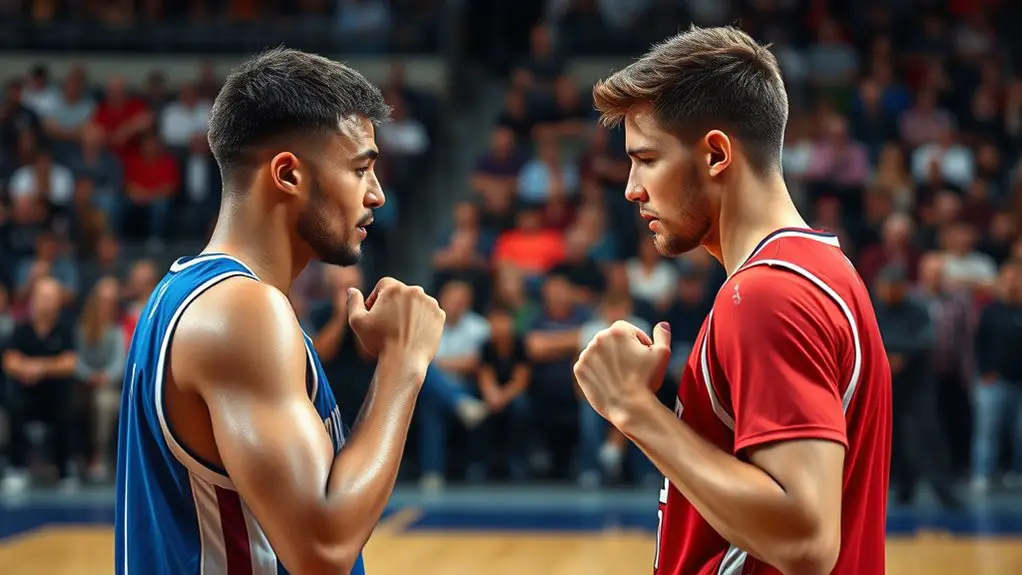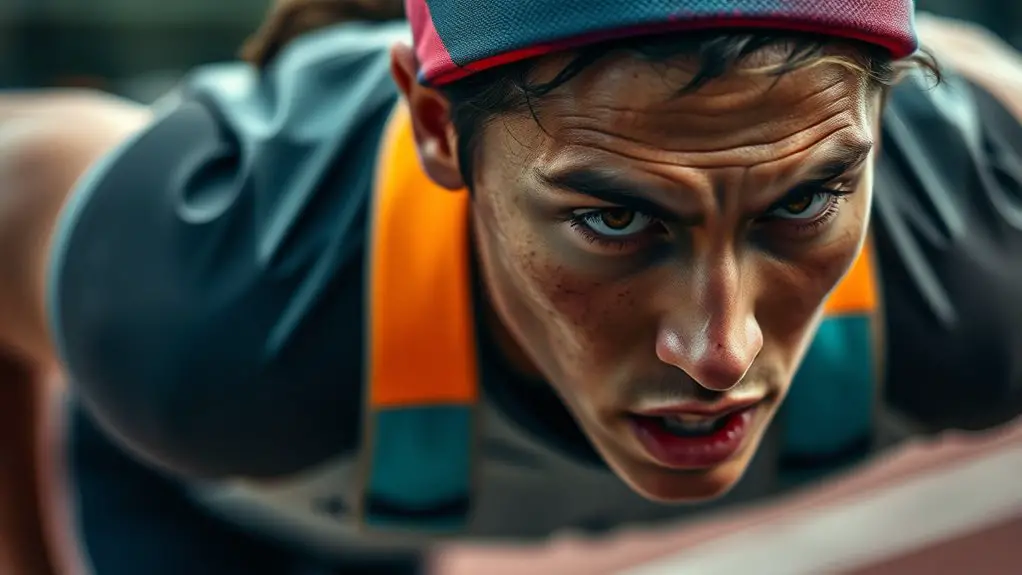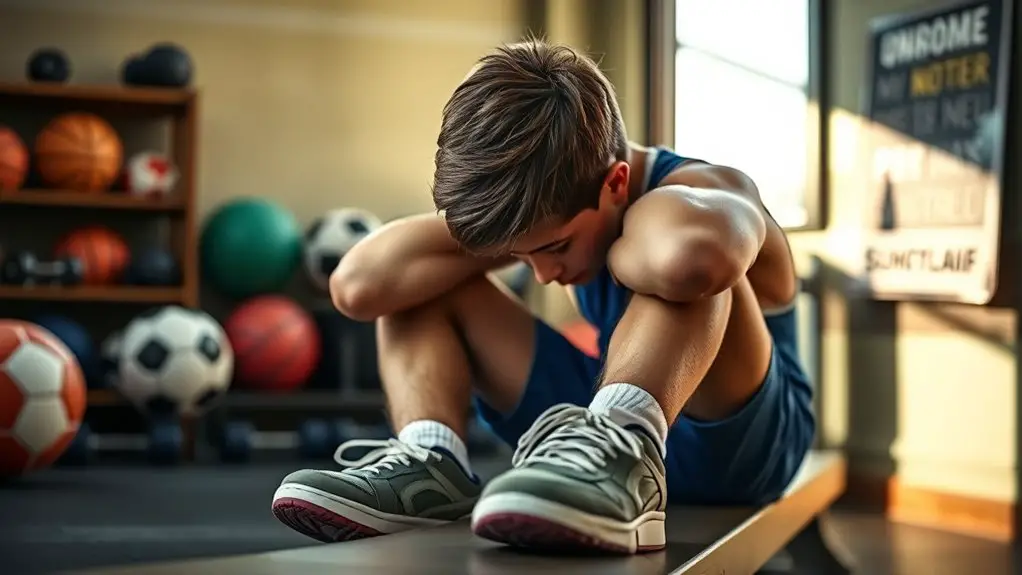Vision training can greatly boost your performance as a quarterback by enhancing your visual skills. It sharpens your decision-making, helping you read defenses quicker and more accurately. By improving focus, tracking, and reaction time, you'll feel more confident on the field. Techniques like cognitive drills and eye exercises are tailored to your needs, ensuring you get the most out of your training. There's much more about how specific drills can transform your game.
Understanding Vision Training
When you think about a quarterback's success, you might not immediately consider the role of vision training. Yet, it's essential for revealing potential and enhancing performance. Vision training focuses on improving how players perceive and process information on the field, allowing them to make quicker, smarter decisions. A thorough vision assessment helps identify strengths and weaknesses, tailoring training methodologies to each quarterback's unique needs.
The Importance of Visual Skills in Football
In football, your visual skills can make or break a play. Mastering eye tracking techniques, improving depth perception, and honing your anticipation and reaction time are essential for any quarterback. Let's explore how these skills can elevate your game.
Eye Tracking Techniques
Eye tracking techniques play an essential role in developing visual skills for quarterbacks, enabling them to read defenses and make split-second decisions. Mastering these skills can enhance your game and give you that edge on the field. Here's why focusing on eye movement and visual acuity matters:
- Improved Reaction Time: Quick eye movement allows for faster decisions.
- Enhanced Field Awareness: You can spot open receivers and defensive shifts.
- Better Ball Placement: Accurate visual feedback leads to precise throws.
- Increased Confidence: Trusting your visual skills helps you play freely.
Depth Perception Skills
Depth perception is an essential skill for quarterbacks, as it directly impacts their ability to judge distances and make accurate throws. When you're on the field, your depth perception helps you assess the space between you, your receivers, and defenders. With improved visual acuity, you can distinguish how far away a target is, which is vital for executing precise passes. This ability reduces the risk of under or over-throwing, allowing you to connect with your receivers effectively. Vision training focusing on depth perception can elevate your game, giving you that extra edge. By honing this skill, you'll not only enhance your overall performance but also experience a newfound freedom in making those game-changing plays with confidence.
Anticipation and Reaction Time
Improving depth perception sets the stage for another vital skill: anticipation and reaction time. As a quarterback, honing these abilities can elevate your game, allowing you to read defenses and respond swiftly. Effective anticipation development and reaction enhancement empower you to make split-second decisions that can change the outcome of a play.
- Predicting defenders' movements
- Adjusting throws based on receiver routes
- Timing your passes for maximum impact
- Reacting to unexpected situations on the field
Key Components of Vision Training for Quarterbacks
When it comes to vision training for quarterbacks, there are a few key components you can't overlook. You'll want to focus on visual processing techniques, eye coordination drills, and spatial awareness exercises to enhance your performance on the field. Each of these elements plays a vital role in improving your overall game.
Visual Processing Techniques
Visual processing techniques are essential for quarterbacks aiming to enhance their performance on the field. By honing these skills, you can greatly improve your cognitive development and decision-making abilities. Here are some key techniques to reflect on:
- Pattern Recognition: Learn to quickly identify defensive formations and potential plays.
- Depth Perception: Train your eyes to gauge distances accurately, helping you assess throwing lanes.
- Focus Shifting: Practice altering your focus between multiple targets, like receivers and defenders.
- Visual Memory: Strengthen your ability to remember plays and formations, allowing for quicker responses during the game.
Incorporating these visual processing techniques into your training routine will empower you to play with greater freedom and confidence on the field.
Eye Coordination Drills
Mastering visual processing techniques lays a solid foundation for effective eye coordination, which is essential for quarterbacks. Eye coordination drills enhance your visual acuity, enabling you to track moving targets and make split-second decisions. These drills can include tracking a ball with your eyes as it moves at varying speeds or focusing on multiple objects in your field of vision. By incorporating exercises that challenge your hand-eye coordination, you'll improve your reaction time and overall performance on the field. Imagine effortlessly connecting with your teammates while reading the defense—this freedom is attainable through consistent practice of eye coordination drills. Embrace the journey, and watch as your skills elevate, allowing you to play with confidence and precision.
Spatial Awareness Exercises
While many skills contribute to a quarterback's success, spatial awareness is essential for making quick and effective decisions on the field. By honing this ability, you can improve your cognitive mapping of the game, enhancing your overall performance. Here are some key spatial awareness exercises to contemplate:
- Peripheral Vision Drills: Expand your awareness of what's happening around you.
- Field Awareness Simulations: Visualize plays and adapt to various scenarios.
- Obstacle Navigation: Improve your ability to maneuver under pressure.
- Target Tracking: Enhance your focus on multiple moving targets.
Incorporating these exercises into your training routine will help you read defenses better and make smarter plays, ultimately giving you the freedom to excel in high-pressure situations.
Techniques Used in Vision Training
Quarterbacks can enhance their on-field performance through a variety of vision training techniques designed to sharpen their perceptual skills. One popular approach is dynamic visual training, where you practice tracking moving objects, like footballs, to improve your hand-eye coordination. Another effective method is peripheral vision drills, aimed at expanding your awareness of the field, helping you spot defenders or open receivers without having to turn your head.
Additionally, using contrast sensitivity training can help you distinguish between objects in varying light conditions, essential for making accurate throws. You might also explore eye exercises that focus on depth perception, enabling you to judge distances better. Incorporating these visual training methods into your routine can lead to significant quarterback performance enhancement, giving you the freedom to make quicker, more informed decisions during games. Embrace these techniques, and watch your game elevate!
Cognitive Drills to Enhance Decision Making
To elevate your game further, incorporating cognitive drills can greatly enhance your decision-making skills on the field. These exercises nurture cognitive flexibility, allowing you to adapt quickly to changing situations and develop effective decision frameworks. Here are some drills to evaluate:
Incorporating cognitive drills can significantly boost your on-field decision-making and adaptability to dynamic game situations.
- Scenario Simulation: Create game-like situations to practice making rapid decisions under pressure.
- Pattern Recognition: Analyze film or use software to identify plays and trends, sharpening your instinctive responses.
- Memory Recall: Test your ability to remember and apply previous plays, enhancing strategic thinking.
- Role-Playing: Switch roles with teammates to understand different perspectives and improve collaborative decision-making.
Eye Exercises to Improve Focus and Tracking
Improving your focus and tracking skills is essential for making accurate throws and reading defenses effectively. Integrating focus exercises and tracking drills into your routine can elevate your game. Here are some effective exercises you can try:
| Focus Exercises | Tracking Drills |
|---|---|
| Target fixation: Stare at a stationary object for 10 seconds, then shift focus to moving targets. | Pencil push-ups: Hold a pencil at arm's length and slowly bring it closer to your nose while keeping it in focus. |
| 3D shape recognition: Identify shapes in your environment to enhance spatial awareness. | Ball toss: Partner tosses a ball while you focus on catching it with peripheral vision. |
| Visual scanning: Practice scanning the field by looking at different areas rapidly. | Dot tracking: Follow a moving dot on a screen or paper with your eyes without moving your head. |
Incorporating these exercises can sharpen your ability to read the game and respond swiftly.
The Role of Technology in Vision Training
As you work on enhancing your focus and tracking skills, technology can play a significant role in your vision training. Embracing modern tools can take your game to the next level, giving you an edge over the competition. Here are some ways technology can help:
Enhance your focus and tracking skills with modern technology to elevate your game and outshine the competition.
- Virtual simulations: Engage in realistic scenarios that mimic game situations, allowing you to practice decision-making without physical strain.
- Augmented reality: Experience a blend of real-life and digital elements, enhancing your awareness of the field.
- Vision training apps: Use specialized apps that offer drills and exercises tailored to improve your visual skills.
- Performance analytics: Analyze your training sessions to identify areas of improvement and track your progress over time.
Additionally, integrating AI-enhanced performance analytics can provide insights into your visual strengths and weaknesses, further optimizing your training regimen.
With these tools at your disposal, you can reveal your full potential and gain the freedom to make sharper, quicker decisions on the field. Embrace technology and elevate your game!
Success Stories: Quarterbacks Who Have Benefited
Many quarterbacks have transformed their performance by integrating vision training into their routines, proving that these techniques can make a significant difference on the field. Take, for instance, a quarterback who struggled with reading defenses. After committing to vision training, he increased his completion percentage and led his team to the playoffs, showcasing one of many success stories.
Another example is a young talent who, after focusing on visual processing skills, became a standout player, earning accolades for his quarterback achievements. These stories aren't just about physical prowess; they highlight the mental edge gained through dedicated training.
When you see these quarterbacks flourish, it's clear that vision training isn't just an accessory to their game; it's a game-changer. So, whether you're still on the sidelines or stepping into your next big play, remember these success stories as inspiration for your own journey.
Future of Vision Training in Football
While the past few years have seen significant advancements in vision training techniques, the future holds even more promise for quarterbacks looking to elevate their game. As training innovations continue to emerge, you can expect future trends that revolutionize how you approach your performance on the field.
- Integration of virtual reality for immersive training experiences
- Wearable tech that tracks eye movement and cognitive response
- Enhanced neurocognitive exercises to improve decision-making speed
- AI-driven personalized training programs tailored to individual needs
These innovations will not only refine your visual skills, but also enhance your overall game awareness. Imagine training with tools that adapt to your unique playing style, helping you access your full potential. Embracing these advancements lets you take control of your development, ensuring you're equipped to face any challenge that comes your way. The future of vision training is bright, and it's time to seize the opportunity.
Frequently Asked Questions
How Long Does Vision Training Typically Take to Show Results?
When you're diving into vision training, you might wonder how long it takes to see results. Typically, training duration varies, but many people start noticing performance improvement within a few weeks to a couple of months. It really depends on your commitment and how consistently you practice. If you're dedicated, you could experience significant changes in your skills and abilities, giving you the freedom to perform at your best. So, stay motivated!
Can Vision Training Help With Injuries or Recovery?
Vision training can definitely play a role in injury prevention and recovery techniques. By honing your visual skills, you're not just enhancing your performance but also improving your awareness on the field, which can help you avoid dangerous situations. When you're recovering from an injury, focusing on your vision can aid in re-establishing coordination and confidence. So, yes, it can be a valuable part of your overall recovery strategy, giving you the freedom to play at your best.
Is Vision Training Effective for All Positions in Football?
Vision training can be effective for various positions in football, not just quarterbacks. Each position has unique demands, and players can benefit from improved visual skills tailored to their roles. For instance, receivers might enhance their tracking abilities, while linemen can sharpen their peripheral vision. By focusing on position-specific benefits, you can elevate overall performance, ensuring that every player maximizes their potential on the field. Embracing this training could truly transform your game.
What Age Should Players Start Vision Training?
When you think about youth development, consider the difference between starting early and waiting too long. It's often best to introduce vision training techniques around ages 8 to 10. At this age, players are enthusiastic to learn and adapt quickly. Early training can build essential skills while keeping the game enjoyable. If you wait too long, you might miss out on valuable growth opportunities. So, why not start fostering those skills now?
Are There Any Risks Associated With Vision Training?
When considering vision training, it's vital to understand that there are some misconceptions surrounding its safety. While it's generally beneficial, you should be aware of potential side effects, like eye strain or discomfort. It's important to approach training wisely, ensuring you're following guidelines and listening to your body. Remember, you're in control of your training journey, so prioritize your well-being and consult a professional if you have any concerns.




